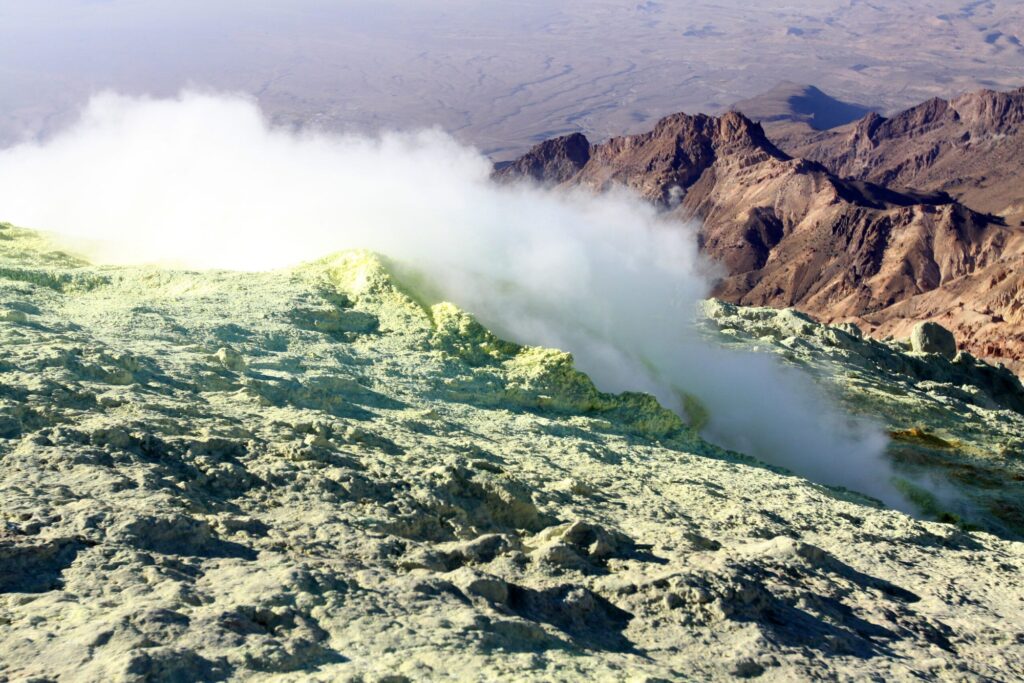
For decades, the colossal Taftan volcano of eastern Iran stood as a lifeless monument to the past, towering nearly 13,000 feet above the desert landscape. However, in 2023, a remarkable transformation began as the summit started to rise. Over a span of ten months, satellite imagery revealed that the summit had risen approximately 3.5 inches and has not subsided since.
Scientists assert that this subtle bulge, observed from July 2023 to May 2024, is a clear indication that Taftan is not extinct. It may even be on the verge of reawakening.
A Subtle Signal from the Depths
The discovery was reported by a team led by volcanologist Pablo González at Spain’s Institute of Natural Products and Agrobiology (IPNA-CSIC). Utilizing data from the European Space Agency’s Sentinel-1 satellite, González and PhD student Mohammadhossein Mohammadnia detected the slow rise—a change imperceptible to the naked eye but significant enough to alter the volcano’s summit.
Their study, published in Geophysical Research Letters, determined that the movement was not caused by rainfall or earthquakes. Instead, it originated deep within the volcano, between 1,600 and 2,000 feet beneath the summit. Here, gases and hot fluids appear to be building pressure within the hydrothermal system, or perhaps a small bubble of magma has migrated upward.
“It must let it out somehow someday, either explosively or silently,” González stated in an interview with Live Science. He emphasized that while there’s no indication of an imminent eruption, Taftan requires more attention.
The Volcano That Wouldn’t Sleep
Volcanoes are deemed extinct if they have not erupted during the Holocene era—the last 11,700 years. Taftan was once thought to belong to this category, with its last recorded eruption dating back more than 700,000 years. Yet, recent signs suggest otherwise.
Since 2023, residents have reported sulfurous odors and smoky fog emanating from the crater. The gas smell was so potent that it reached the city of Khash, located about 50 kilometers away. These events prompted researchers to re-examine satellite images and confirm the ground deformation.
Taftan’s summit is marked by fumaroles—gas vents releasing substances like water vapor, carbon dioxide, sulfur dioxide, and hydrogen sulfide. During the uplift phase, the team recorded a sulfur dioxide release of approximately 20 tons daily, a significant increase indicating heightened underground pressure. Two additional intense gas bursts on May 16 and 28, 2024, suggested further escalation in the volcano’s internal plumbing system.
Capturing the Ground’s Secret Movement
High-precision monitoring of such slow and small movements demands exceptional accuracy. Scientists employed a new analytical approach called a common-mode filter, which cancels out atmospheric noise to provide cleaner satellite readings. By applying this technique to Sentinel-1 radar data, they detected surface motions of just a few millimeters.
Over ten months, the ground directly beneath Taftan’s summit bulged upwards while the flanks sloped gently outward—typical behavior for gas or hot fluid injection beneath. What was unusual is that the uplift has not tapered off. While such episodes typically persist for only a brief period and ease within weeks, this one continues unremittingly, implying sustained pressurization.
Previous research using similar techniques had observed a fleeting summit bulge at Taftan years ago—a phenomenon that grew approximately 4 centimeters high and did not last longer than a few weeks before dissipating. The newly developed, sustained deformation indicates the volcano’s underlying systems are far from stable.
A Living Volcano Above a Shifting Earth
Taftan is situated atop the Makran subduction zone, where the Arabian Plate is sliding beneath the Eurasian Plate. This slow collision drives volcanism and earthquakes in Iran and southern Pakistan. The burial of oceanic crust allows for the release of fluids that melt the mantle above, forming magma that feeds volcanoes like Taftan.
Even if magma doesn’t reach the surface, heat flow and gas movement can reshape the landscape above. “Our results indicate that Taftan is more active than it was previously believed to be,” wrote the study authors. The event, they continue, calls into question the entire Makran volcanic arc, where other peaks may also be quietly active.
A Wake-Up Call for Monitoring
Unlike better-known volcanoes in the US or Japan, Taftan lacks ground-based monitoring equipment or an observatory. The region’s remoteness, mountainous terrain, and security concerns make fieldwork challenging. Consequently, satellite technology has become an invaluable resource.
“Satellite radar gives us eyes where it’s too hazardous or out of reach to go,” González explained. By cross-referencing repeat photos from different orbits, scientists can detect when the ground is moving upward, downward, or tilting—often before such changes are visible to the naked eye.
González clarified that the objective is not to alarm local populations but to encourage investment in regional surveillance networks. “This study doesn’t want to create alarm for the people,” he said. “It’s an alarm for local authorities to invest some money to explore this.”
Understanding Taftan’s Risks
For now, Taftan does not pose an imminent threat, but its revival cannot be dismissed. If pressure continues to build, the volcano might one day unleash that energy—potentially through minor steam-powered explosions or larger blasts.
Local communities such as Khash in Iran and the Pakistan border town of Taftan could experience ashfall, poor air quality, or contaminated water if such events occur. More explosive eruptions could endanger crops and buildings with lava or pyroclastic flows.
However, most scientists view this situation as a reminder that Earth’s systems are dynamic and in constant flux. A volcano might lie dormant for centuries and then quietly stir beneath the ground before anyone notices.
Practical Implications of the Research
The findings at Taftan demonstrate the power of satellite radar in observing volcanoes worldwide—especially where ground monitoring is limited. Remote sensing can detect subtle ground movements long before they become apparent, providing advance warning of potential activity.
By refining these methods, scientists can make more accurate predictions of when volcanoes will awaken, potentially saving lives and assets. The research also challenges long-held assumptions about extinct volcanoes. Taftan’s gradual uplift reminds us that “extinct” doesn’t always mean “inactive.”
More broadly, the research enhances global efforts to map hidden geothermal systems, which could eventually be harnessed for clean energy production. Understanding how fluids and heat travel beneath the surface also improves our knowledge of earthquakes, mountain formation, and the Earth’s inner workings.
The research findings are available online in the journal Geophysical Research Letters.
Related Stories
- New computer model predicts volcano collapses and tsunamis
- Massive underwater volcano off the coast of Oregon is getting ready to erupt
- New research shows why Bolivia’s ‘Zombie’ volcano is stirring after 250,000 years
Like these kinds of feel-good stories? Get The Brighter Side of News’ newsletter.





